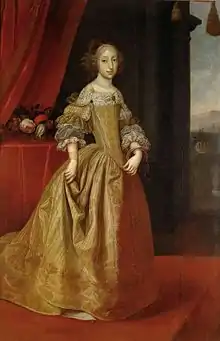Maria Antonia of Austria
Maria Antonia of Austria (Maria Antonia Josepha Benedicta Rosalia Petronella;[1] 18 January 1669 – 24 December 1692) was an Electress of Bavaria by marriage to Maximilian II Emanuel, Elector of Bavaria. She was the eldest daughter and only surviving child of Holy Roman Emperor Leopold I and his wife Margaret Theresa of Spain. She was the heir to the Spanish throne after her maternal uncle Charles II of Spain from 1673 until her death.
| Maria Antonia of Austria | |
|---|---|
 | |
| Electress consort of Bavaria | |
| Tenure | 15 July 1685 – 24 December 1692 |
| Born | 18 January 1669 Hofburg Palace, Vienna |
| Died | 24 December 1692 (aged 23) Hofburg Palace, Vienna |
| Burial | 25 December 1692 |
| Spouse | |
| Issue Detail | Joseph Ferdinand |
| House | Habsburg |
| Father | Leopold I, Holy Roman Emperor |
| Mother | Margaret Theresa of Spain |
Life
Her birth was the result of the inbreeding chronic in the Habsburg family during the sixteenth and seventeenth centuries. Her father Leopold was her mother's maternal uncle and paternal first cousin once removed. Also, her maternal grandparents, King Philip IV of Spain and Queen Mariana, were uncle and niece. Since her childhood, Maria Antonia was an intelligent and cultivated girl, sharing her parents' passion for music.
The last Habsburg king of Spain, Charles II, never fathered any children, due to his severe deformities and illnesses. According to the laws of succession in Spain, Maria Antonia would have had the right to inherit the crown had she lived long enough, because she was the only surviving child of Empress Margaret Theresa, Charles II's sister. During her childhood, it was decided that she would marry her maternal uncle, Charles II, but this plan came to nothing due to political circumstances.
As an alternative, she became a candidate for marriage to Victor Amadeus II of Sardinia, the Duke of Savoy, but nothing came of these plans either.
Electress
Maria Antonia finally married Maximilian II, the Elector of Bavaria, on 15 July 1685 in Vienna. Maximilian married her in the hope of succeeding to the Spanish throne by her rights. Their marriage was very unhappy, as the extroverted Maximilian and the introverted and serious Maria Antonia had little in common. Maria Antonia was reportedly offended by Maximilian's constant infidelity, and when he was appointed governor of the Spanish Netherlands, and left for Brussels in the company of his mistress countess Canozza, Maria Antonia left for her father in Vienna to give birth, and it was widely assumed that she did not intend to return to him.
As the niece of Charles II of Spain, Maria Antonia was of great relevance in connection with the succession to the Spanish throne, which was a major political issue in late 17th-century Europe. One of her sons, Joseph Ferdinand, was of central importance to European politics at the end of the seventeenth century in spite of his youth, as a claimant to the throne of Spain in anticipation after his mother of the extinction of the House of Habsburg in that country. Joseph Ferdinand's death before that of Charles II, the last Habsburg king of Spain, helped to trigger the War of the Spanish Succession. If he had survived Charles, the European powers likely would have permitted him to accede to the throne of Spain.
Issue
- Leopold Ferdinand of Bavaria (22 May 1689) died at birth.
- Anton of Bavaria (19 November 1690) died at birth.
- Joseph Ferdinand of Bavaria (28 October 1692 – 6 February 1699)
Ancestors
References
- Berger, Theodor (1739), Die Durchläuchtige Welt, Oder: Kurtzgefaßte Genealogische, Historische und Politische Beschreibung ..., Korn, p. 6
Bibliography
- Friedrich Weissensteiner: Liebeshimmel und Ehehöllen - Heyne Taschenbuchverlag 1999 - ISBN 3-453-17853-X